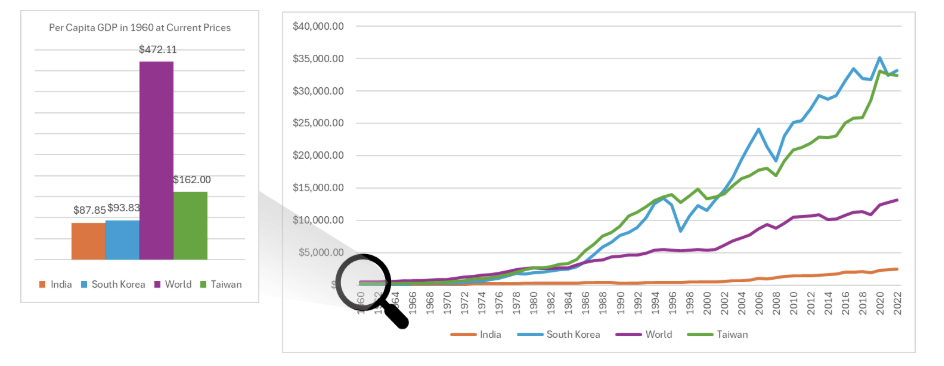Thank you dear subscribers, we are overwhelmed with your response.
Your Turn is a unique section from ThePrint featuring points of view from its subscribers. If you are a subscriber, have a point of view, please send it to us. If not, do subscribe here: https://theprint.in/
Per capita GDP is the most comprehensive metric to determine the progress of a nation and its people. It is the only indicator that correlates with human development indicators, social indicators and poverty alleviation. Figure 1 below illustrates the per capita GDP trend between 1960 and 2023 for India, South Korea, Taiwan and the World average, along with a callout to the per capita GDP for the respective entities in 1960.

What is striking is that in 1960, all these countries had per capita GDPs that were well below the global average. South Korea and Taiwan have shown tremendous growth in their per capita GDP, while India continues to languish well below the world average. One can argue that unlike India, South Korea and Taiwan are smaller countries implying that it is easier to govern smaller countries; and have been shielded by the defensive umbrella of the United States during the Cold War which meant they did not need to spend valuable time and money in strategic defense against belligerent nuclear armed neighbors. In the same vein, it must also be noted that if a country is smaller, then it also has proportionately fewer resources. Both South Korea and Taiwan do not possess a rare natural resource that the world especially needs, like oil, which can explain their tremendous growth. Being under the umbrella of the United States is not free of reciprocity. The people of these countries have made significant efforts to become critical additions to critical global supply chains. Taiwan’s advancements into chip manufacturing and South Korea’s acquired indispensability in memory chips, OLED displays, and shipbuilding have been very critical to the deployment of the American defensive umbrella. We should be careful and not explain away the difference in per capita GDP growth between India and these countries to geo-political providence and their respective sizes.
A very short diagnosis
The diagnosis of the underperformance of India is solely attributed to the reason that we do not have firms that produce goods and services for which the world is willing to pay a premium. We do not yet have the equivalent of Samsung, Hyundai, TSMC or Foxconn from India. It should be of great concern that India, with approximately 18% of the world population contributes only 2.5% of the world’s exports, whereas Taiwan and South Kore, a with a combined population that is 1% of the world’s population, contribute to more than 4% of the world exports. GDP is made in firms. India does not have world-beating firms; ergo, we are not rich.
The Nexus of Populist Politics and Inept Administrative Services
There should be no doubt that our Administrative State has been incompetent. Enough proof of this is visible in our poorly managed cities, our decrepit public education and health services, a middling record on law and order, and unresolved cases in the courts. Our political class is still muddled in failed populist economic ideologies across all parties subscribing to welfarism, identity politics, and protectionist (Swadeshi) instincts that induce voters to falsify their preferences at the ballot to avoid negative outcomes such as collective punishment. This, in part, is caused by the inevitability of the Condorcet paradox that plagues our electoral process. One must remember that the average turnout for even state elections in India ranges only between 60-70%, implying that the 30-40% who do not vote are larger in number than the electorate that voted for the winning candidate in most scenarios. This presents a great opportunity for political entrepreneurs, and it would be ideal if there were a polity that represented liberal globalism that presents a choice in opposition to populist nationalism.
Need for a Political Economy that Espouses Liberal Globalism
India could learn from South Korea and Taiwan on how they have organized their politics around Liberal Globalism. Better governance through legislative and financial autonomy at the county (District level), a low tariff regime that encourages competition in the free markets while also enabling the creative enterprises of their own peoples to produce world beating goods and services have produced remarkable firms across several niche industries. Both countries have premium Markets such as the US and Europe as their largest trading partners. This has happened through competitive private firms. Freeing up government regulations and wasting tax-payer money on government involvement in private goods is also vital for accelerating growth of per capita GDP through firms.
A party that can espouse a liberal globalist message can enthuse the 30-40% who don’t vote.
These pieces are being published as they have been received – they have not been edited/fact-checked by ThePrint.


